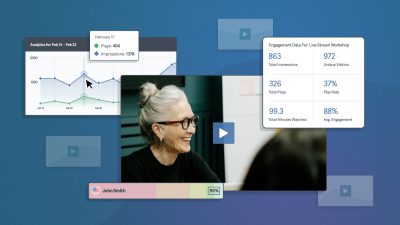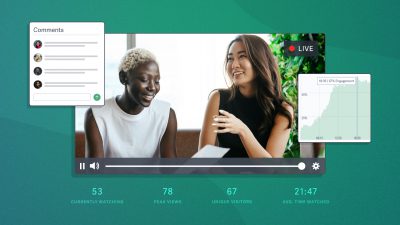B2B companies have been slow to jump on the video marketing bandwagon. For some, it’s a concern of equipment, not having the right team in place, or lacking the budget to make videos.
For still others, it’s a matter of not knowing how to measure their video marketing return-on-investment. After all, if you can’t track it, how can you be sure you’re getting your money’s worth?
Today, we’re going to focus on this particular challenge by analyzing five different B2B video marketing goals, and looking at real world examples along the way.
Defining Success for B2B Video Campaigns
The right metrics will help you determine if your video campaign was successful or not, but you have to know what to track. The right pieces of data to pay attention to will be determined by your video marketing campaign goal and where it falls in your customer lifecycle. Video metrics you might look at include:
- Impressions: how many people visited the page where your video is located
- Plays: the total number of times your video has been viewed
- Play Rate: the percentage of website visitors that click play
- Engagement Rate: the percentage of a video that the viewer watched
For more nitty gritty details on these metrics, refer to our help documentation for our analytics and video engagement metrics.
Other important data points to track are more variable in how they’ll be tracked or calculated because they depend on how you’ve set up your campaign. For our purposes, you’ll likely want to pay attention to the following:
- Conversion Rate: the percentage of people that complete an intended action
- Social Shares: the number of times your video is shared on any given social network
Whatever your campaign goal, with clear data, you can evaluate your success.
Below, we share five common examples of B2B video marketing campaign goals. We’ve laid out related video ideas, as well as the metrics required to help you determine their efficacy.
Goal #1: Establish Your Brand as a Leader in Your Industry
Thought leadership campaigns are an excellent way to reach new audiences and to establish your brand as a trusted household name.
These particular campaigns are not really about immediately converting buyers. Instead, they’re focused on creating awareness and name recognition.
They also rely heavily on trust. Viewers need to have confidence your expertise, and authority on a topic.
Once your audience begins to trust and respect your brand, it will spill over to the products and services you offer. Ultimately, it will also result in more business. Here’s an example of how you can approach this with video.
Showcase Customer Challenges and Opportunities
Customers are often facing similar challenges when they seek the solution your business offers. On the surface, their problems might look really different. But, when you dissect the real issues at hand, there’s often a lot of commonality you can explore with targeted video content.
In a captivating and well-produced series of videos, Square, a payment processing solution for businesses, really sets the standard for this type of video. Here’s our favorite, but you can watch the other videos in this series here.
It’s emotional, it’s inspirational, and it’s extremely real. It also speaks directly to Square’s target audience – independent entrepreneurial business owners. After watching, you walk away thinking, “If they can do it, so can I!” And, what a powerful message that is.
By demonstrating that they truly understand the challenges their target market is facing, Square establishes trust and drives brand recognition with this engaging video series.
Metrics to Track
For awareness-focused campaigns, it’s all about building a trustworthy reputation as an industry leader. That means reach, and how viewers respond, will be key indicators of success.
To establish reach, look at the total number of impressions and plays your video received. You’ll also want to track social shares for this video.
In addition, if you’ve enabled commenting, look for emotional indicators in the language used in the comments. Are viewers happy? Sad? Angry? Understanding their reactions will help you know if your video hit the mark.
Goal #2: Generate New Leads
One of the most important functions of any marketing team is to generate qualified new leads for their sales team to pick and run with. Here are several ideas, and the corresponding metrics that will help you to determine whether your campaign is effective or not.
Gated Premium Content
Sometimes, your company has the luck, or budget, to make a truly spectacular piece of content. It might be an interview with an industry thought-leader, or an exclusive sneak peek at something. Either way, it’s heavy-hitting and can’t be found anywhere else.
Gating your video requires that viewers share their email address in order to view the video. Once you’ve captured that lead, you can send it straight to the marketing platform of your choice. From there, you can deploy targeted messaging to nudge your leads along in your sales funnel.
An Engaging Product Video
A product video is your opportunity to pitch your value proposition straight to a potential customer. If a customer watches your product video the whole way through, their level of interest and engagement is likely very high. It is therefore safe to assume that they’re very intrigued by your product, and would be amenable to contact from your sales team in order to learn more.
Importantly, product videos don’t have to be boring! Here’s a fun example from Zendesk about their customer support platform:
Zendesk skillfully uses humor to show off the importance of providing good customer support. By keeping their brand in the background, they make it all about the end result for the customer. After all, that’s what Zendesk’s customers care about the most!
To capitalize on your viewers’ interest, use a post-play screen to display a signup page, or to direct traffic to a sales page. Visitors might make a purchase on the spot, or enter contact information to get in touch with sales.
Metrics to Track
The key metrics to keep an eye on here are the engagement rate, and the conversion rate and ROI on your call-to-action.
The engagement rate will indicate how much of your video your viewers actually watched. The closer to 100%, the better.
The conversion rate calculation will vary a little depending on the action you’re asking viewers to take. The simplest way to calculate it is to take the number of people who took the action, and divide that number by the number of people who had the opportunity to do so. For instance, if 10 people visit your landing page, and 5 of them sign up for your email list, your conversion rate is 5/10 or 50%.
Evaluating ROI is more complex. If your CTA is to make a purchase, you’ll want to look at number of sales, average order value, and whether a customer is new or returning. If you’re just gathering leads, you can assign a value to each lead, and use that to calculate your ROI instead.
Goal #3: Re-engage Lost Leads
Nobody likes to lose a hard-earned lead, but it happens. Leads might leave their position and be replaced by new people you don’t know; they can end up on the wrong email list and unsubscribe; or they might simply become too busy and overwhelmed at work to respond to your offers.
Whatever the explanation, there’s no reason to be dismayed. A cold lead is better than getting a hard “NO.” After all, you still have an opportunity to win them over.
So what kind of video marketing campaigns are likely to be successful in re-engaging leads that have gone radio silent?
Product Releases and Updates
Use new products or updates to remind customers what they’re missing, and entice them to make a purchase. Events like these are exciting, and your video should reflect that.
For example, a few years ago, Apply built a whole campaign around the excitement of newness for the iPhone 6S.
It’s memorable, it’s hilarious, and, importantly, it’s shareable, even by non-techies who don’t obsess over every new feature. Don’t be afraid to tap into consumer holidays, humor, or even a sense of drama with your B2B videos.
Personalized Video
Personalized videos show your audience that the people who make up your organization are listening, understand their needs, want to provide them with solutions, and are thinking ahead on their behalf. This can go a long way in building customer rapport, and in being viewed as a trusted and reliable source for information.
After all, who doesn’t like to feel special?
Metrics to Track
Here, the engagement rate and conversion rate are helpful metrics. You might also use this campaign to drive social shares. After all, why not add new prospects to your funnel while re-engaging your existing leads?
Goal #4: Improve the Customer Experience.
Contrary to what some may think, video marketing still plays an important role once your lead becomes your customer. Retention can be as key to growth as new customer acquisition.
In order to keep your customers happy, you will want to keep them updated and engaged. Here are some ideas for using video to improve the customer experience.
Product Hacks and Tips
These videos serve to keep your customer in the loop about your current offering. It’s possible your existing customers could benefit from new features, or new ways your products can be used. Be sure to include helpful updates and offers that don’t always require them to spend more money.
For instance, Zendesk is often used by companies to handle email support, but they also have phone support options as well. This part of their product isn’t as well-known, but they’ve done a great job coming up with humorous content to advertise it.
By showing the other side of phone support, and highlighting the experience of the agent, Zendesk’s video highlights how ridiculous the average phone support call can be. It also speaks to their target audience because every company wants to provide good customer service over the phone.
Behind-the-Scenes Videos
Help your customer see you and your team as not just another vendor, but as a passionate team working hard to help them to be successful. Focus on showing them the ways you are helping them to stay ahead of their competition. Here’s our guide to making successful behind-the-scenes videos.
Customer Stories and Testimonials
Hearing from other customers can help create a sense of community. These videos can be used to highlight your offerings without coming across as too sales-y. We have some great tips for getting customer testimonials on camera.
Salesforce offers a wealth of examples. One of our favorites is the Amazon Web Services customer story.
Metrics to Track
Play rate and engagement rate will be helpful to you here. Pay attention to the engagement rate to better understand what matters most to them.
Goal #5: Shore Up Our Reputation
Crisis PR can benefit greatly from video marketing. Rather than rely on a press release or social media update about a serious issue that may affect your reputation and bottom-line, use video to start a dialogue with your online audience.
Direct Addresses From C-suite Executives
Acknowledge and apologize for the problem, and share next steps for solving it. While it can be painful to admit failure, videos like this provide reassurance to your audience and allow you to move forward.
For instance, British Airways suffered a major technical glitch that grounded planes and caused significant travel disruptions for people and businesses alike. The CEO of British Airways published a video on Twitter apologizing for the situation, and explaining how they were handling it.
— British Airways (@British_Airways) May 27, 2017
When the buck stops with you, it’s important for your customers to hear from you when things go wrong. British Airways gets bonus points for their direct, frank, and reassuring approach.
“How We Solved the Problem”
Release videos that show your team working hard, and explaining how you’re instituting practices to avoid similar issues in the future. These types of video are great to use in addition to the direct addresses from your executives because they provide proof of your commitment to improve. Put another way, seeing is believing.
Customer Testimonial Videos
Try featuring a client who discusses how they were affected by the problem. More importantly, showcase how your company went above and beyond to rectify it. Third-party accounts like this can be especially powerful.
Metrics to Track
Ideally, you want to reach as many affected customers as possible with your message. The metrics you will want to monitor are social reach, play rate and engagement rate.
As with any PR crisis, monitoring social media for consumer sentiment is very important. Try to respond directly to anyone having immediate issues, and direct others to resources that can help. Save the data analysis for an internal post-mortem, and focus on providing assistance in the moment.
The play rate and engagement rate will show you how many people actually received your message. You’ll especially want to use the engagement data to ensure your viewer makes it to the portion of the video that shows you’re making headway on resolving the issue, and whatever led up to it.
No matter your B2B marketing goal, or where it falls in the customer lifecycle, video can be the best tool at your disposal. Set clear goals, and track the relevant data to measure your success.
If you have questions, or are about to launch a new B2B campaign, we’d love to hear about it! Please share in the comments below.








